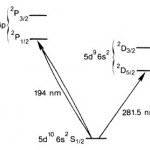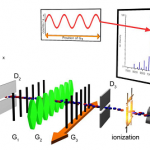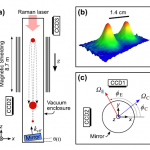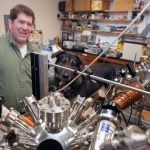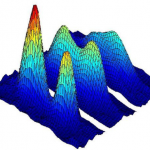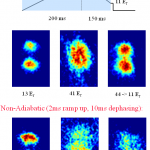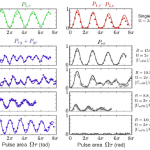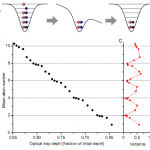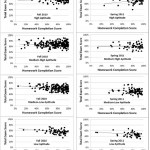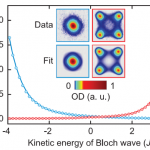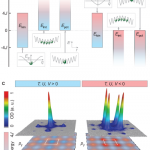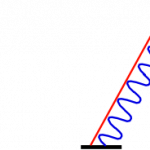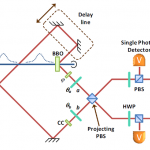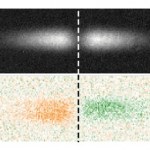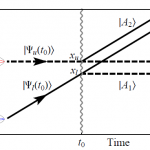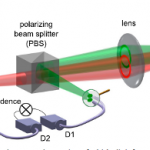researchblogging
In a weird coincidence, shortly after I wrote a post about "quantum leap" as a metaphor, I was looking up some stuff about John Bell and ran into mentions of a paper he wrote called "Are There Quantum Jumps?" Bell is borrowing a title from Schrödinger, who wrote a pair of articles (really, one article in two pieces) for the British Journal for the Philosophy of Science in 1952 expressing his discontent with the entire idea of "quantum jumps" between states. Bell even opens his paper with a quote from Schrödinger: "If we have to go on with these damned quantum jumps, then I'm sorry that I ever…
I'm teaching Quantum Optics this term, and one of my students picked "Atom Optics" off the list of suggested paper topics. When he asked for pointers, I said "You should check out the diffraction stuff Markus Arndt's group does." And just like that, a paper from the Arndt group turns up from the Arxiv Blog...
This is apparently only recently posted to the arxiv, though the article in Physical Chemistry Chemical Physics claims to have been online since July. Since I never get tired of talking about this, let's talk about this one, too.
So, what's this one about, then? In a lot of ways, it's…
A little over a year ago, I visited Mark Kasevich's labs at Stanford, and wrote up a paper proposing to use a 10-m atom interferometer to test general relativity. Now, that sounds crazy, but I saw the actual tower when I visited, so it wasn't complete nonsense. And this week, they have a new paper with experimental results, that's free to read via this Physics Focus article. Which might seem to make me blogging it redundant, but I think it's cool enough that I can't resist.
OK, dude, "Multiaxis Inertial Sensing with Long-Time Point Source Atom Interferometry" is not the sexiest title in the…
I have a small collection of recent research papers that I'd like to write up open in various browser tabs and suchlike, but many of these would benefit from having some relatively clear and compact explanations of the underlying techniques. And while I can either dig up some old posts, or Google somebody else's, it's been a while since I wrote some simple, straightforward explanations of physics techniques, so I thought it'd be fun to write up some new explanations for use in future posts. Thus, this introduction to a series of techniques commonly used in my corner of Atomic, Molecular, and…
Yesterday's write-up of my Science paper ended with a vague promise to deal some inside information about the experiment. So, here are some anecdotes that you would need to have been at Yale in 1999-2000 to pick up. We'll stick with the Q&A format for this, because why not?
Why don't we start with some background? How did you get involved in this project, anyway? I finished my Ph.D. work at NIST in early 1999, graduating at the end of May. I needed something to do after that, so I started looking for a post-doc by the don't-try-this-at-home method of emailing a half-dozen people I knew…
In Monday's post on squeezed states, I mentioned that I really liked the question because I had done work on the subject. This is, in fact, my claim to scientific fame (well, before the talking-to-the-dog thing, anyway)-- I'm the first author on a Science paper with more than 500 citations having to do with squeezed states. And since I've never written it up on the blog before, I'll leap on this opportunity to do some shameless self-promotion...
Well, aren't we Mr. Ego today? What's this paper that you're so impressed with about? I've never been all that good with titles, but I like to think…
I'm always a little ambivalent about writing up papers that have also been written up in Physics: on the one hand, they make a free PDF of the paper available, which allows me to reproduce figures from the paper in my post, since I'm not breaking a paywall to do it. Which makes it much more attractive to write these up. On the other hand, though, they do a pretty good job writing accessible descriptions, so there's not that much for me to add.
In the case of this paper, I'll write it up anyway (albeit somewhat more briefly than usual, because they already did a nice job), just because the…
Hey, dude? Yeah, what's up?
I'm not normally the one who initiates this, but I was wondering: When you were at DAMOP last week, did you see any really neat physics? Oh, sure, tons of stuff. It was a little thinner than some past meetings-- a lot of the Usual Suspects didn't make the trip-- but there were some really good reports from a lot of groups.
Anything really surprising? Well, there was one talk that I really liked a lot, that I went to on a lark, because I didn't understand what the session title could possibly mean, and there was no abstract for the talk: Experimental Studies of…
One of the perennial problems of teaching intro physics is getting students to do their homework, so I was very interested to see Andy Rundquist on Twitter post a link to a paper on the arxiv titled "How different incentives affect homework completion in introductory physics courses." When I shared this with the rest of my department, though, I got a link to an even more interesting paper from the same group, on the effect that doing homework has on student performance. This has an extremely surprising conclusion: for the weakest students in introductory physics, doing more homework actually…
Last week's post talked about the general idea of negative temperature, with reference to this much-talked-about Science paper (which also comes in a free arxiv version from which the figures used here are taken). I didn't go into the details of how they made a negative temperature gas, though, and as it's both very clever and hard to follow, I figure that deserves a post of its own.
Right, so last time you said that negative temperature just means you're more likely to find fast-moving atoms than slow ones, so all they need to do is whack these atoms in the right way? Right? No, it's more…
The most talked-about physics paper last week was probably Negative Absolute Temperature for Motional Degrees of Freedom (that link goes to the paywalled journal; there's also a free arxiv preprint from which the above figure is taken). It's a catchy but easily misinterpreted title-- Negative absolute temperature! Below Absolute Zero! Thermodynamics is wrong!-- that obscures the more subtle points of what's going on here. So, in the interest of clarity, I'm going to attempt an explanation, over the course of a few posts, but given my schedule these days, that might spread over a couple of…
In which I unpack a cryptic paper title and explain how quantum superposition lets you use light to keep things from interacting with light.
-------------
I joined AAAS a couple of years ago to get a break on the registration fee for their meeting, and I've kept up the membership mostly because I like having individual access to Science articles, so I can read them in the coffee shops where I get actual work done. This also gives me access to articles in the "advance online publication" stage, which is hilarious because Union's institutional subscription doesn't include those articles-- if I'…
In which we do a little ResearchBlogging to look at a new paper about weird quantum effects, entangling two photons that never both exist at the same time.
------------
I'm teaching full-time this term, but I've blocked out Thursdays as a day when I don't do class- or chair-related work. Usually, this means trying to write something on the work-in-progress, but I finished a short thing in the morning that needed to sit for a few hours before I looked at it again, which left a nice opportunity for some blogging. And, conveniently, somebody retweeted a New Scientist story about an arXiv…
So, it's been a while, but let's see if we can't hit the ground running with a good physics post. There have been a few notable physics events since I went on hiatus, but for a return to physics ResearchBlogging, we'll go with something near and dear to my heart, ultracold atoms. Specifically, this Science paper (free arxiv version) about passing atoms through a narrow channel. This is a cool bit of subfield-crossing physics, so let's dust off the Q&A format, and go through it.
Hey, dude, long time no see. So, what's the deal with this paper? Well, the title pretty much tells you what's…
In which we look at a slightly crazy-sounding proposal from my former boss, the experimental realization of which is getting close to completion.
------------
I spent more or less the entire first day of DAMOP a couple of weeks ago going to precision measurement talks. Most of these were relatively sedate (at least by the standards of a sub-field that routinely involves people proposing incredibly difficult experiments), but my boss when I was at Yale, Mark Kasevich, provided the bold proposals I usually expect, in this case suggesting an experiment using an atom interferometer to measure…
In which we do a little ResearchBlogging, taking a look at a slightly confusing paper putting a new twist on the double-slit experiment.
------------
I'm off to California this afternoon, spending the rest of the week at DAMOP in Pasadena (not presenting this year, just hanging out to see the coolest new stuff in Atomic, Molecular, and Optical Physics). I don't want to leave the blog with just a cute-kid video for the whole week, though, so here's some had-core physics: a new paper in the Proceedings of the National Academy of Sciences (freely available online), looking at a new sort of…
Enough slagging of beloved popularizers-- how about some hard-core physics. The second of three extremely cool papers published last week is this Nature Physics paper from the Zeilinger group in Vienna, producers of many awesome papers about quantum mechanics. Ordinarily, this would be a hard paper to write up, becase Nature Physics are utter bastards, but happily, it's freely available on the arxiv, and all comments and figures are based on that version.
You're just obsessed with Zeilinger, aren't you? All right, what have they done this time? The title is "Experimental delayed-choice…
I've been busily working on something new, but I'm beginning to think I've been letting the perfect be the enemy of the good-enough-for-this-stage, so I'm setting it aside for a bit, and trying to get caught up with some of the huge number of things that have been slipping. Which includes getting the oil changed in my car, hence, I'm sitting in B&N killing time, which is a good excuse to do some ResearchBlogging.
Last week was a banner week for my corner of physics, with three really cool experiments published. Two of those are on the arxiv, which means I can use images from the paper (…
Richard Feyman famously once said that the double-slit experiment done with electrons contains everything that's "'at the heart of quantum physics." It shows both particle and wave character very clearly: the individual electrons are detected one at a time, like particles, but the result of a huge number of detections clearly traces out an interference pattern, which is unambiguously a wave phenomenon. The experiment has been done lots of times, but a particularly nice realization of it comes from Hitachi's R&D department, where you can see both still images and video of their experiment…
It's been a while since I did any ResearchBlogging posts, because it turns out that having an infant and a toddler really cuts into your blogging time. Who knew? I keep meaning to get back to it, though, and there was a flurry of excitement the other day about a Nature Physics paper proposing a way to search for quantum gravity not with a billion-dollar accelerator, but with a tabletop experiment. There's a write-up at Ars Technica, but that comes at it mostly from the quantum gravity side, which leaves room for a little Q&A from the quantum optics side.
Wait a minute, you said this is in…
